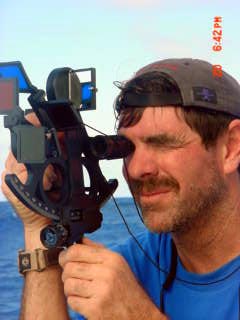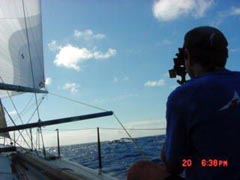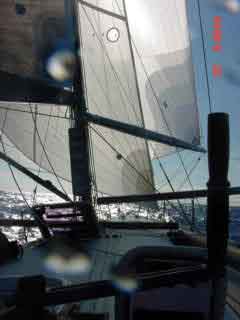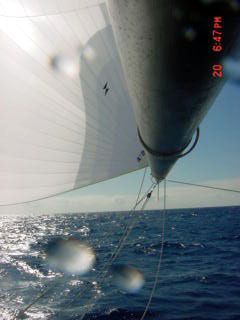Thursday July 20th
Position: Latitude: 23 14 North Longitude: 147 10 West, Course Over Ground: 297 true, Speed Over Ground: 13 knots
Skipper’s notes: Fly Pegasus fly!….. Dance with the wind and the waves!…. Fly Pegasus fly!….. A perfect day. A Perfect night: Warm, fast, completely enjoyable. On board, I am now also Mark Rudiger’s apprentice navigator. What better master than Mark. After all, Mark was the Navigator for the last winning Volvo/Whitbread challenge: “EF Language” working with Paul Cayard to dominate the whole race. Mark has been across the Pacific 14 times, including single handed. Mark has done single handed trans-Atlantic races in both directions. I personally consider Mark the best in the world. Bar none. Check out Mark’s website at http://www.teamrudiger.com . On-board Pegasus, When we navigate, we use computers, communications satellites as well as several GPS systems. By training I am a technologist, so all these on-board digital tools are second nature to me. But there is one navigation tool that fascinates me more than any other one: The sextant. Amazing, a simple optical and mechanical device that combined with a good watch can tell us with great accuracy where we are in the world. Basically I’m fascinated with low tech devices like the sextant that produce great high tech answers and will still function when all the AA batteries on the planet are used up and all the orbiting satellites have stopped operating. Not that this will ever happen. Navigating by the stars, the planets and the Sun is a noble art that we can’t collectively forget. Like fencing, archery or handwriting. Let’s note that the Ancient Polynesians we’re even a step ahead, making long passages across the Pacific without a compass or a clock and pinpointing remote islands with astounding precision. The ancient art of navigation of the Polynesians was almost lost when a revival movement started a couple of decades ago. I see the sextant in a similar light. A noble tradition that must live-on. Like music and fine arts. Today, Mark started showing me his sextant and how to “shoot the Sun.” Which in “Sextant Language” means measuring as precisely as possible the position of the Sun above the horizon. A couple of ephotos show Mark and his precious sextant. So as the Sun was going down, on-board the mighty Pegasus we were talking about the huge size of our 38 feet spinnaker pole: That’s bigger than many boats entered in this race! It sticks out 18 feet in front of the forestay. It allows us to carry huge spinnakers that give Pegasus the power of flight in the pitch dark night. Later, in a couple of hours, the Moon will rise, then the Sun and in the daylight we will know how fast we sailed. Fly, Pegasus fly!….

Mark setting up his sextant

Mark takes a sextant site

Downwind with a large spinnaker and a staysail

The Pegasus huge 38ft spinnaker pole